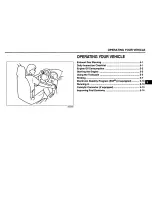
The TPMS will warn the driver of a low tire pressure if the
tire pressure falls below the low-pressure warning limit for
any reason, including low temperature effects and natural
pressure loss through the tire.
The TPMS will continue to warn the driver of low tire
pressure as long as the condition exists, and will not turn
off until the tire pressure is at or above the recommended
cold placard pressure. Once the low tire pressure warning
(Tire Pressure Monitoring [TPM] Telltale Light) illumi-
nates, you must increase the tire pressure to the recom-
mended cold placard pressure in order for the “Tire
Pressure Monitoring Telltale Light” to turn off. The system
will automatically update and the “Tire Pressure Monitor-
ing Telltale Light” will turn off once the system receives the
updated tire pressures. The vehicle may need to be driven
for up to 20 minutes above 15 mph (24 km/h) in order for
the TPMS to receive this information.
For example, your vehicle may have a recommended cold
(parked for more than three hours) placard pressure of
30 psi (207 kPa). If the ambient temperature is 68°F (20°C)
and the measured tire pressure is 27 psi (186 kPa), a
temperature drop to 20°F (-7°C) will decrease the tire
pressure to approximately 23 psi (158 kPa). This tire
pressure is sufficiently low enough to turn ON the “Tire
Pressure Monitoring Telltale Light.” Driving the vehicle
may cause the tire pressure to rise to approximately 27 psi
(186 kPa), but the “Tire Pressure Monitoring Telltale Light”
will still be ON. In this situation, the “Tire Pressure
Monitoring Telltale Light” will turn OFF only after the tires
are inflated to the vehicle’s recommended cold placard
pressure value.
CAUTION!
•
The TPMS has been optimized for the original
equipment tires and wheels. TPMS pressures and
warning have been established for the tire size
equipped on your vehicle. Undesirable system op-
eration or sensor damage may result when using
replacement equipment that is not of the same size,
type, and/or style. Aftermarket wheels can cause
sensor damage.
•
Using aftermarket tire sealants may cause the Tire
Pressure Monitoring System (TPMS) sensor to be-
come inoperable. After using an aftermarket tire
sealant it is recommended that you take your vehicle
to an authorized dealership to have your sensor
function checked.
(Continued)
396
STARTING AND OPERATING
Summary of Contents for Chassis Cab 2017
Page 4: ......
Page 10: ......
Page 288: ...8 4 8 4 NAV With Manual Temperature Controls 286 UNDERSTANDING YOUR INSTRUMENT PANEL ...
Page 289: ...8 4 8 4 NAV With Automatic Temperature Controls 4 UNDERSTANDING YOUR INSTRUMENT PANEL 287 ...
Page 298: ...Operating Tips Chart 296 UNDERSTANDING YOUR INSTRUMENT PANEL ...
Page 305: ...Uconnect 5 0 Radio Uconnect 8 4 8 4 NAV Radio 4 UNDERSTANDING YOUR INSTRUMENT PANEL 303 ...
Page 307: ...Uconnect 5 0 Media Uconnect 8 4 8 4 NAV Media 4 UNDERSTANDING YOUR INSTRUMENT PANEL 305 ...
Page 452: ......
Page 513: ...MAINTENANCE SCHEDULES CONTENTS 䡵 MAINTENANCE SCHEDULE 512 Maintenance Chart 513 8 ...
Page 525: ...INDEX 10 ...
















































